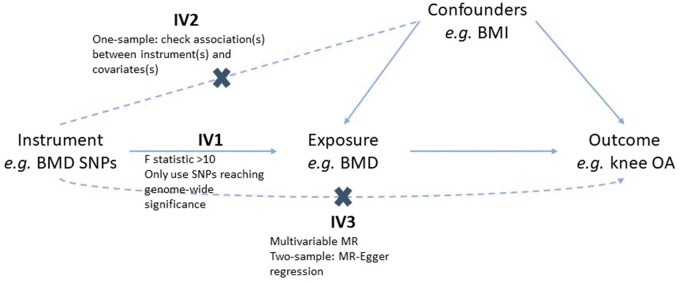Figure 2.
Assumptions of Mendelian randomization and how we tested these assumptions
For a Mendelian randomization (MR) effect estimate to be valid, the instrument(s) must satisfy three key assumptions:3 IV1 [the instrument(s) must be robustly associated with the exposure], IV2 [the instrument(s) must not be associated with any confounders of the exposure–outcome relationship] and IV3 [the instruments(s) can only be associated with the outcome via the exposure and not via a different biological pathway independent of the exposure (i.e. horizontal pleiotropy)]. In one-sample analyses, IV1 was tested by calculating the F-statistic, which is a measure of instrument strength. A >10 threshold is used to determine sufficient instrument strength.2 IV2 was tested by determining the association between the instruments and potential confounders of the exposure–outcome relationship. In two-sample analyses, to satisfy IV1, we ensured that all instruments were robustly associated with the exposure by only including SNPs associated with the exposure at genome-wide significance. To address IV3, MR–Egger regression was performed to generate an estimate of horizontal pleiotropy (intercept) and a pleiotropy-robust estimate of the causal effect (slope). Weighted median regression was performed to determine the robustness of IVW estimates as weighted median estimates are valid even if ≤50% of the SNPs are not valid instruments.20 BMD, bone mineral density; BMI, body mass index; OA, osteoarthritis; SNP, single-nucleotide polymorphism.

